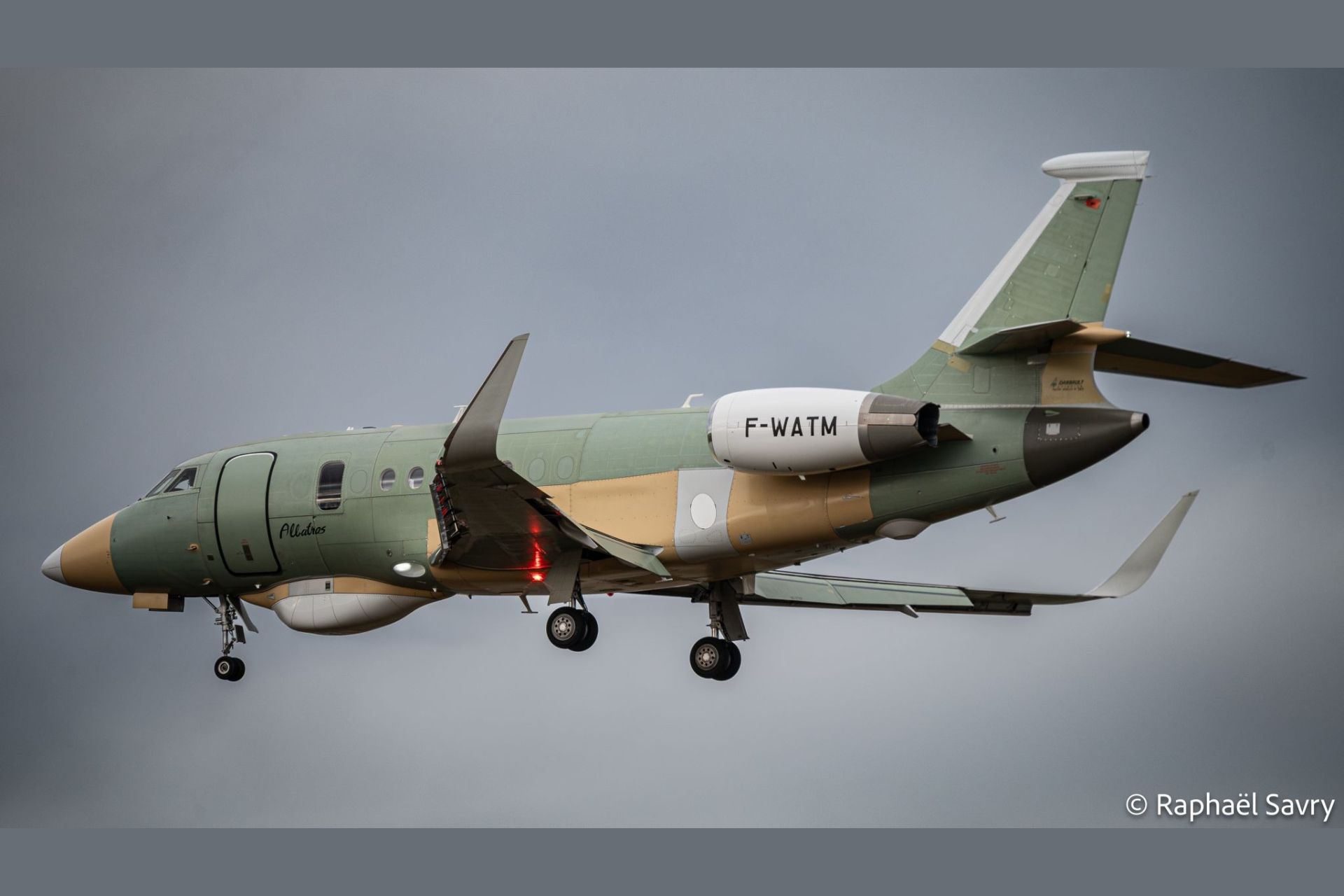Dassault Aviation Albatros Takes First Flight Enhancing French Maritime Surveillance

{loadposition bannertop}
{loadposition sidebarpub}
On Friday, January 24, 2025, the prototype of the Dassault Aviation Albatros successfully completed its maiden flight from Bordeaux-Mérignac Airport, temporarily registered as F-WATM. This initial flight, which was not officially announced by the manufacturer, was captured by Bordeaux-based photographer Raphaël Savry.
Follow Army Recognition on Google News at this link
Derived from the Falcon 2000LXS business jet, the Albatros features a configuration adapted to maritime surveillance missions (Picture source: Raphaël Savry)
The Albatros is being developed as part of the AVSIMAR program (Maritime Surveillance and Intervention Aircraft), launched by the French Ministry of the Armed Forces after years of delays and included in the 2019-2025 Military Programming Law. An initial order of seven aircraft has been placed, with an option for five additional units that may be confirmed by the end of the year.
Derived from the Falcon 2000LXS business jet, the Albatros features a configuration adapted to maritime surveillance missions. Unlike traditional maritime patrol aircraft, it is not designed for anti-submarine warfare or strike operations but is intended for monitoring fishing zones, maritime migration flows, pollution control, and search and rescue missions. It is set to replace the Falcon 50M and Gardian currently in service with the French Navy and to complement the capabilities of the future Airbus A321 MPA.
Images of the maiden flight reveal several distinguishing features of the Albatros. A Thales Searchmaster multifunction radar is visible under the forward fuselage, enhancing surface surveillance, similar to the modernized ATL2 aircraft. The aircraft’s nose has been modified, indicating enhancements in detection capabilities. A large rectangular observation window is visible on the left side of the fuselage, facilitating aerial surveillance, while an under-fuselage installation in the rear is likely intended for the Safran EuroFLIR 410 electro-optical infrared system.
The Albatros stands out for its range and endurance capabilities. With an operational endurance of seven hours at 200 nautical miles from the coast, it surpasses the performance of the Falcon 50M and Gardian, enabling extended missions in French overseas territories. It will be capable of strategic connections between New Caledonia and Tahiti, two key areas under French military command in the Pacific region.
The aircraft is equipped with the latest navigation and communication technologies. It features an anti-jamming GPS, a next-generation inertial navigation system, and a SATCOM system with L22 data link capability. Like its predecessors, it will be capable of deploying sea rescue equipment.
From an industrial perspective, Albatros production will be split between France and India. The first three aircraft are currently being assembled at Dassault Aviation’s Bordeaux-Mérignac facility, while the subsequent units will be produced in Nagpur by Dassault Reliance Aerospace Limited (DRAL). However, all airframes manufactured in India will be transferred to Mérignac for conversion to military standards.
The Albatros is expected to be presented at the Paris Air Show in June 2025, where it could be displayed alongside other key Dassault Aviation aircraft, such as the Rafale M in its F4 standard. With the successful completion of its first flight, the program is progressing toward its scheduled entry into service beginning in 2025.

{loadposition bannertop}
{loadposition sidebarpub}
On Friday, January 24, 2025, the prototype of the Dassault Aviation Albatros successfully completed its maiden flight from Bordeaux-Mérignac Airport, temporarily registered as F-WATM. This initial flight, which was not officially announced by the manufacturer, was captured by Bordeaux-based photographer Raphaël Savry.
Derived from the Falcon 2000LXS business jet, the Albatros features a configuration adapted to maritime surveillance missions (Picture source: Raphaël Savry)
The Albatros is being developed as part of the AVSIMAR program (Maritime Surveillance and Intervention Aircraft), launched by the French Ministry of the Armed Forces after years of delays and included in the 2019-2025 Military Programming Law. An initial order of seven aircraft has been placed, with an option for five additional units that may be confirmed by the end of the year.
Derived from the Falcon 2000LXS business jet, the Albatros features a configuration adapted to maritime surveillance missions. Unlike traditional maritime patrol aircraft, it is not designed for anti-submarine warfare or strike operations but is intended for monitoring fishing zones, maritime migration flows, pollution control, and search and rescue missions. It is set to replace the Falcon 50M and Gardian currently in service with the French Navy and to complement the capabilities of the future Airbus A321 MPA.
Images of the maiden flight reveal several distinguishing features of the Albatros. A Thales Searchmaster multifunction radar is visible under the forward fuselage, enhancing surface surveillance, similar to the modernized ATL2 aircraft. The aircraft’s nose has been modified, indicating enhancements in detection capabilities. A large rectangular observation window is visible on the left side of the fuselage, facilitating aerial surveillance, while an under-fuselage installation in the rear is likely intended for the Safran EuroFLIR 410 electro-optical infrared system.
The Albatros stands out for its range and endurance capabilities. With an operational endurance of seven hours at 200 nautical miles from the coast, it surpasses the performance of the Falcon 50M and Gardian, enabling extended missions in French overseas territories. It will be capable of strategic connections between New Caledonia and Tahiti, two key areas under French military command in the Pacific region.
The aircraft is equipped with the latest navigation and communication technologies. It features an anti-jamming GPS, a next-generation inertial navigation system, and a SATCOM system with L22 data link capability. Like its predecessors, it will be capable of deploying sea rescue equipment.
From an industrial perspective, Albatros production will be split between France and India. The first three aircraft are currently being assembled at Dassault Aviation’s Bordeaux-Mérignac facility, while the subsequent units will be produced in Nagpur by Dassault Reliance Aerospace Limited (DRAL). However, all airframes manufactured in India will be transferred to Mérignac for conversion to military standards.
The Albatros is expected to be presented at the Paris Air Show in June 2025, where it could be displayed alongside other key Dassault Aviation aircraft, such as the Rafale M in its F4 standard. With the successful completion of its first flight, the program is progressing toward its scheduled entry into service beginning in 2025.






